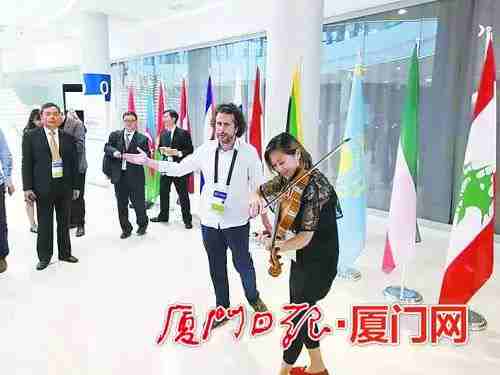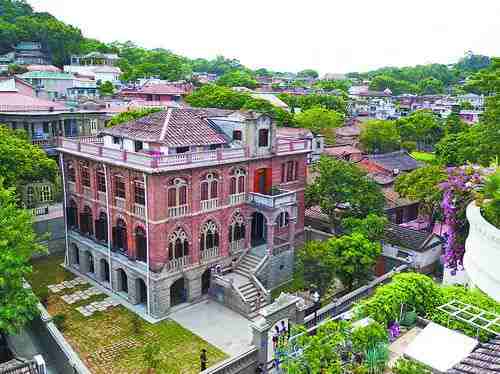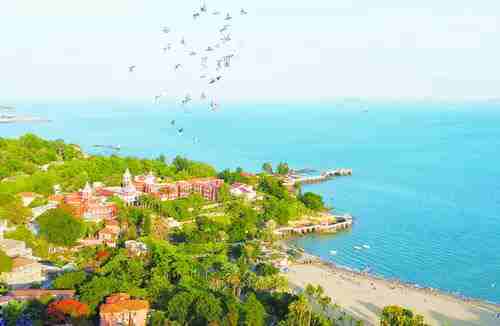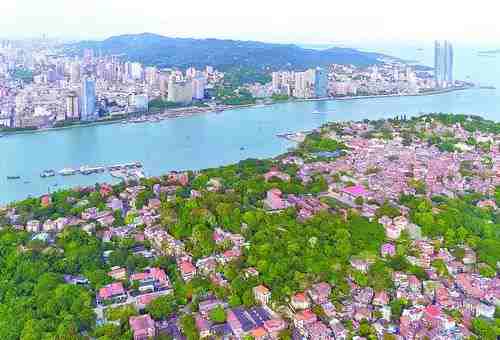一段跨越太平洋的异国恋情,美国人Robin眼中独具魅力的鼓浪屿原来是这样的


鼓浪屿上从来不缺乏动人的异国恋情
不久前,鼓浪屿中提琴演奏家杨璟和美国男友乐宾在波兰共同见证了鼓浪屿申遗成功。而他们的结缘,同样是“鼓浪屿历史国际社区”的一个美好见证。


一起来品读乐宾眼中独具魅力的鼓浪屿
学习原滋原味的英文吧
Treasured Island
By Robin Goldstein
The historical international settlement of pedestrian only Gulangyu Island, in the bay of Xiamen, was made a UNESCO World Cultural Heritage Site at the 41st United Nations World Heritage Committee meeting in Krakow, Poland on July 8.
I first saw Gulangyu (known in the local dialect as Kulangsu) through the eyes of my partner, Yang Jing, a concert violinist who grew up on this 1.88 square kilometers islet. It's just an islet, officially, a small village of about 4,000 households and 14,000 people living on a small island in the shadow of the larger, newer island of Xiamen city.
Yang's family has been in Gulangyu for three generations. Before I set foot on the island, I had heard her CD Kulangsu: Through the Strings of Time -- which combined classical music with natural sounds recorded from around the island -- and Yang had explained to me that there were no cars or bikes allowed on the island.

She had told me of the narrow cobblestone(鹅卵石) streets that wind through hills and spill out onto tropical(热带) beaches lined with coconut palms.
She had described the giant banyan trees shading the graceful European mansions, the romantic couples posing for wedding pictures, and the 13 historical consulates that made Gulangyu look like a Mediterranean island plopped(扑通落下) into the South China Sea.
But not even Yang's tales of beauty and charm could have prepared me for the magical experience of stepping off the ferry onto Gulangyu for the first time.
The 10-minute ferry ride from downtown Xiamen takes less time than your average city taxi trip, but it is a ride into another world, into a Chinese-Western past that you might not even know existed.
Like that of Venice(威尼斯), Gulangyu's air is just something that has to be breathed in to be understood.
Last September, in the midst of the final stages of the UNESCO World Heritage Site inspection process, Typhoon Meranti slammed directly into Xiamen and Gulangyu.
“After eight years of hard work to restore and protect our heritage properties, the biggest typhoon we'd ever seen hit the island three days before the UNESCO inspector was due to arrive,” says director Zheng Yilin of the Gulangyu Administrative Committee.
Xiamen gets a few glancing blows each year during typhoon season, but this was the largest storm to hit the city directly in 50 years.
Nineteen giant ancient trees fell, and more than 3,000 were damaged.
Zheng says that 100 local families lost their homes, and other local families took them in.
“More than 300 volunteers came to help,” she says, including many foreigners living in Xiamen who volunteered all day to clean up debris(残骸) from the beaches and roads. The UNESCO inspection visit was postponed(推迟), but only by a few weeks.
Gulangyu's local government, its citizens, and its volunteers worked day and night hauling(拖运) garbage, clearing floodwaters, re-paving(重新铺) streets, and reconstructing buildings that had been damaged.
A team of plant biologists trimmed and righted and saved hundreds of injured trees and planted thousands of new ones.
Nine months later, the island is as verdant as it's ever been.

Thankfully, almost all of the island's 19th-century Amoy Decostyle mansions, with their graceful archways(拱门) and red-brick facades(外观) that fuse(融合) Minnan (south of Fujian province), or Hokkien(闽南话), and modernist elements into one unique architectural language, survived the storm with only minor cosmetic damage.
So did the many adorable boutique hotels, the brightly colored souvenir shops and kitschy bars, the tropical fruit stands and casual restaurants, and the brave barechested(敞胸的) men who roll wheelbarrows(手推车) of cargo and luggage across the island's steep hills. (Some things are more challenging without cars.)
A few days after the storm, the streetfood bazaar of Long Tou Road was already bubbling again with fragrant casseroles of ginger duck, fresh local clams with garlic and chili, and the most canonical(典型的) local speciality: the oyster omelette(海蛎煎), made with fresh oysters, eggs, scallions(葱), and sweet-potato flour and served with bright red Xiamenstyle hot sauce.
Before long, the 580-seat Gulangyu Concert Hall, an acousticonly venue(听觉场所) that stages free classical concerts for the public almost every night -- from local student recitals(独奏会)to visiting symphony orchestras(管弦乐队) -- was also open again.

Gulangyu is also an island of museums, home to a new satellite branch of the Palace Museum in Beijing's Forbidden City as well as what are without a doubt the world's best and most beautiful piano and organ museums.
This is no accident: When classical music came to China, it first arrived on Gulangyu, and the island has given birth to a long line of great classical musicians, of which Yang is only one of the latest.
She still plays and hangs out with her old teachers and coaches some of the current students of the music school she first entered at age 7.
Perhaps more surprising for visitors whose expectations of China are filtered through the rhetoric(华丽的辞藻) of foreign media, the island is also blessed with temples for believers of all denominations: Protestant churches and Catholic cathedrals, Adventist homes, and a spectacular Buddhist temple that lies at the foot of Sunlight Rock, one of the most beautiful perches in all of China. All of these places are supported and maintained as historical monuments as well as being active places of worship.
If the UNESCO inscription was a particularly modern moment for Gulangyu, it was a rare modern moment, for although this is a community that has been completely international since the mid-1800s, it is also one that turns upsidedown any preconceived notions you might have of internationalism or modernity. It is a place where things are still carried around in wheelbarrows, an island that still operates at walking speed -- andante(缓慢地) -- where the millions of tourists who visit annually can wake up each morning to a symphony(交响乐) of piano notes and birdsong instead of the honking horns(汽车喇叭声) and exhaust fumes(烟) of the cities from which they came.
The civil servants now running the island see themselves as nothing but the current guardians of these precious qualities.
Deputy Director Zhang Shunbin of the Gulangyu Administrative Committee says: “Our hardest challenge is finding a balance between Gulangyu as a tourist attraction, a local community, and a historical monument. We must be careful. We must make sure that local people can still live normal lives even as the island attracts more international attention, for it is the everyday life of the island that also makes it so beautiful.”

链接

关于乐宾
有着十多年旅游传记和美食评论写作经历的他,决定发挥自己的专长,为鼓浪屿撰写一些靠谱的英文旅游攻略——他发现,在谷歌上搜“鼓浪屿”,只有一些过时的景点介绍,找不到实用的信息。
从当地的美食、住宿、人文入手,在鼓浪屿居民苏志明的协助下,乐宾和杨璟花了几个月的时间,拍摄岛上风光、收集实用信息和资料。他们经常通宵工作到天亮,终于在申遗结果公布前,完成了新版的鼓浪屿英文旅游攻略。在管委会的支持下,乐宾还帮助鼓浪屿建立了首个官方中英文网站(https://kulangsuisland.org),并将它推上了谷歌的首页。他同时协助管委会的翻译小组,将岛上53个文化核心要素的简介,编辑成文辞优美的英文。
他们还一同为鼓浪屿申遗举办了4场音乐会,邀请所有在厦外国人前来欣赏。在名为《让世界爱上鼓浪屿》的2017新年音乐会上,乐宾专门创作的五弦中提琴与钢琴合奏曲《鼓浪屿小夜曲》受到了好评。他还作为演出嘉宾,在音乐会上献唱了《鼓浪屿之波》。


厦门日报社新媒体中心出品
综合:China Daily 、厦门日报
编辑:严琦 审核:张薇薇
厦门日报社微信矩阵 | ||||||
昵称 | 微信号 | 昵称 | 微信号 | |||
| 厦门日报 | xiamenribao | 厦门招考 | xiamenzhaokao | |||
| 厦门晚报 | xmwb597 | 海峡生活报 | lifeweekly0592 | |||
| 海西晨报 | haixichenbao | 台海杂志 | taihaizazhi | |||
| 厦门网 | xmnn-cn | 遇见婚恋网 | yujianw520 | |||
 | ||||||
最新评论
推荐文章
作者最新文章
你可能感兴趣的文章
Copyright Disclaimer: The copyright of contents (including texts, images, videos and audios) posted above belong to the User who shared or the third-party website which the User shared from. If you found your copyright have been infringed, please send a DMCA takedown notice to [email protected]. For more detail of the source, please click on the button "Read Original Post" below. For other communications, please send to [email protected].
版权声明:以上内容为用户推荐收藏至CareerEngine平台,其内容(含文字、图片、视频、音频等)及知识版权均属用户或用户转发自的第三方网站,如涉嫌侵权,请通知[email protected]进行信息删除。如需查看信息来源,请点击“查看原文”。如需洽谈其它事宜,请联系[email protected]。
版权声明:以上内容为用户推荐收藏至CareerEngine平台,其内容(含文字、图片、视频、音频等)及知识版权均属用户或用户转发自的第三方网站,如涉嫌侵权,请通知[email protected]进行信息删除。如需查看信息来源,请点击“查看原文”。如需洽谈其它事宜,请联系[email protected]。